 In today’s post I have my notes from last nights demo, as well as paintings for the day.
In today’s post I have my notes from last nights demo, as well as paintings for the day.
As was the case last year, his studio painting demonstration was unbelievable. He finished 90% of the painting in a little over two hours. I didn’t see him make a single drawing or painting mistake. You can see the incredible value of experience and practice. Here are my notes from the night:
- His canvas was roughly 4’x5′, toned a light value 3 gray with gesso mixed with blue/black gray acrylic paint. Smooth linen, sanded I imagine between coats.
- He began by marking the edges of the canvas with objects on the boarder of the still life, with precise horizontal and versicle indicators, sometimes and diagonal.
- He drew the entire still life in a thinned down burnt sienna. There were so many objects, his draftsmanship was spot on.
- He then layed in his darks, starting with some fairly chromatic greens, then going to violets. His layin colors were all the same value, just varying hue and temperature. Lots of warm/cool variations at this stage. I noticed too that 90% of his background darks were layed in with verticle strokes, probably due to the fact that in a gallery environment with light overhead, verticle strokes reflect the least amount of light, horizontal the most.
- I didn’t see him use a drop of thinner or medium. I spoke to his assistant, Vickie Reese, at the break and she confirmed that he adds oil to some colors to keep them all the right consistency, about that of mayonnaise. Some Classic Artist Oils are a bit heavy out of the tube (eg, Cobalt, Hansa Yellow Orange), so you need to add Linseed Oil to get them the same consistency as Ultramarine Blue, for example. I imagine that’s why he doesn’t need to use thinner or medium at this stage, as the paint as enough oil in it to move smoothly across the canvas and yet retain it’s tinting strength.
- During this initial lay-in, lots of blending between strokes, no hard edges, and most are so soft they blend together.
- During the lay-in, he used one brush, only once or twice cleaning in turps.
- When he rose the values up, he stayed in the midtones range, where the pigment has it’s most power (since there’s no white in it to both cool it and dull it). I was amazed how close he kept his values in the early stages, really for 80% of the painting–nothing above a midtone.
- His color during the initial lay-in was not raw, out of the tube, yet it was articulate. You new the color, it didn’t stray off into too gray/chalky. I think the lesson here is to try painting the first 80% of your painting with no white whatsoever. You’d be surprised how vibrant the painting will stay.
- The shadow side of most objects where blended right into the background (ie, “lost edges”).
- Although he worked all over the canvas, he generally completed one object at a time, laying in both the shadow side and a midtone for what would be the light side. Later, he’ll lay in these lights right over the midtone paint, which is applied lightly with brush fully loaded (so you don’t scrape into the under midtone paint. Even when applying lights, he did lots of blending back into the midtone and darks. Only occasionally would he highlight something and leave a hard edge. He’d so this with objects like the ridges of rose petals, for example.
- He didn’t end up putting the finishing touches in the painting, but said he rather wanted to think about it and finish it later than night or the next day.
Now, for today’s efforts. I decided to really focus on the initial lay-in and try to avoid painting details too early. This is REALLY difficult for me. I have a relatively short attention span and like to complete one thing before moving on to another. I think I did okay, but have Ovanes’ critique below on a couple of the paintings.
I tried not to bring this to completion, but probably painted more than I should have. I just can’t help adding those juicy highlights! Ovanes felt the background lights were too light, and the table top a bit too chalky (too much white). He thought the vase and flowers worked well.
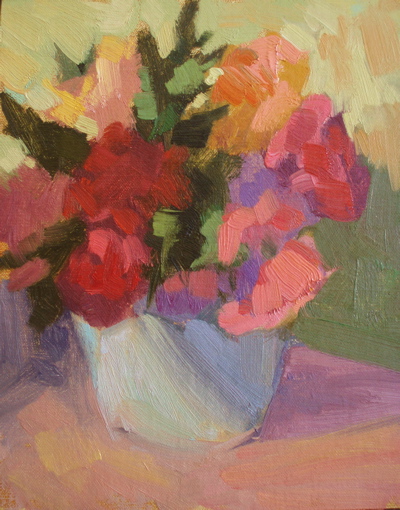
Ovanes Workshop Still Life 2, Oil on Linen, 10×8Ovanes suggested some value corrections (shown in this final study). He generally thought the values were correct, and made some color suggestions. As like the first one, he felt the background ground in sun was too light a value. I liked it so left as is.
I did this quick study and a couple of others (all scraped) before calling it quits. My neighbor painting today was “PK”, who it turns out found out about the workshop through this blog. She’s shown below standing in front of an initial layin–notice, no white! She was a lot of fun. Turns out, she play Alice from “Alice in Wonderland” at Disneyland in 1960. Can’t you just picture her? She had some funny anequdotes about Walt Disney, himself, since he auditioned her for the part. Sounds like it was a great job, part of history really.
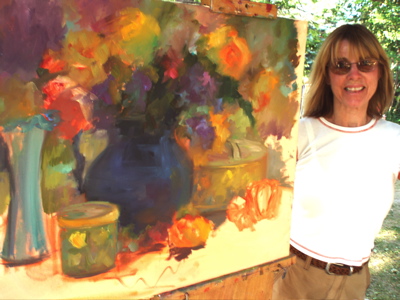
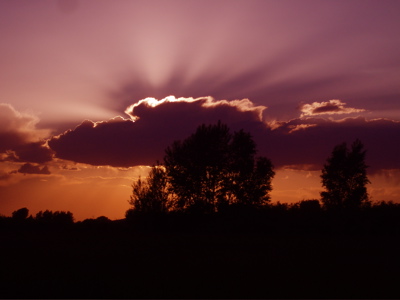
Update: To get on the email list to attend a Ovanes Berberian workshop, contact Ray Morrison:
BERBERIAN WORKSHOPS
1838 YALECREST AVE
SALT LAKE CITY, UT 8410
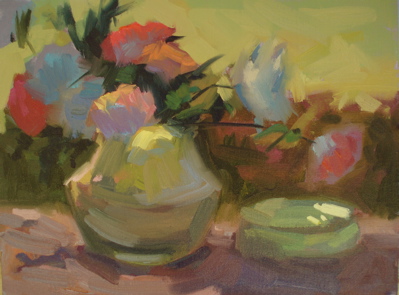
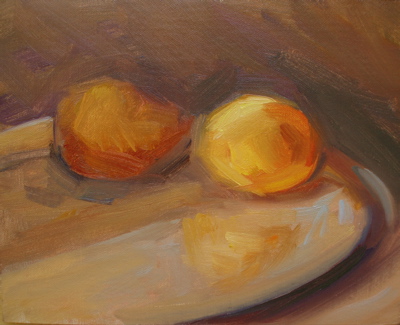
Lucky you. Nice work and thank you for your notes.
Regarding:
His layin colors were all the same value, just varying hue and temperature.
Could you expand on this? Was his whole canvas one value or were all darks equal to dark values and different than all midvalues which were equal to midvalues?
I’m sort of lost on the not using any white as well. For example, using thalo and ultramarine blues (palette limited to split 6 colors), how could you get a light blue without using white?
Thanks for any help you can offer.
Wayne
Super work. Lucky man. Thanks for posting your notes.
Regarding:
His layin colors were all the same value, just varying hue and temperature.
Was his whole canvas the same value or just all his darks=darks and med = med, light=light?
I’m not sure I understand the non use of white. Regarding the no white issue; using a limited palette of split comp, how could you get a light blue (thalo/ultramarine) without using white?
Wonderful photos and generous posting. The paintings here are just outstanding. Can’t wait to see more.
Wayne, I shouldn’t have said he used no white whatsoever, he does, but very small amounts. He takes advantage of the value of pigment out of the tube. So, for example, a yellow ochre with no white will be lighter than Ultramarine Blue. Since objects in light are often a warm color, and most of the warm colors on his palette are a light value out of the tube, he doesn’t need to add much white.
He doesn’t paint the entire lay-in inexactly the same value, it’s just that they are surprisingly close in value. Some artist’s I’ve studied with, like Camile Przwodeck, really push the value changes early on to show light/shadow separation. Ovanes doesn’t. He focuses more on temperature changes, and paints lights on his midtones (surprisingly, without creating muddy colors…again, probably due to his light touch and the amount of paint loaded on his brush).
Eilo Camacho reads this blog too, so perhaps he’ll chime in with his own perspective, since he also studied with Ovanes.
PS. I should add that Ovanes doesn’t allow photographs to be taken in his studio, however, Ray Morrison (who sets up these workshops), does make DVDs of every demo. I’ve heard they’re sold on eBay as well, but just did a search and found none. If you’re interested in the DVD, email Ray at ray@trioeditions.com
Ed,
Thank you very much for your time and explanations. Really appreciate it.
Sorry about the double post earlier .. the server here opted out so I didn’t think the first post made it.
Ed,
This is great. I think your doing an outstanding job.
I actually think not showing Ovanes’s demo on the net is a benifit. The internet would lose a lot of the subtle temperture changes you are describing. I have an unfinished demo from years ago that Ovanes gave me. A lot gets lots in the photgraphs when compared to the original so I think you are describing it MUCH better then the photos could do it justice. Unless of course he let you close enough to take close-ups.
Ok…I will try to make a few things clearer….
1. Definition of “chalky” Could mean to much white, to much of any pigment, not enough temperture change. In the above painting…the table top has to much white for a warm area.
2. Use of white…Well without seeing his pallette I can’t tell you how much white he is using. The reason is, there are probably mixtures of pre-mixed “greys” that he using as “mother” colors. Did you notice those Ed? If they are there those have a lot of white in them but they are mixed with a lot of pigment too.
Ovanes is not a formula painter…he really is just that good. I had the fortune of painting with him outside the workshops so I have a hard time breaking down his workshop technique because it varied from the experience of painting alongside him. I hope this helped.